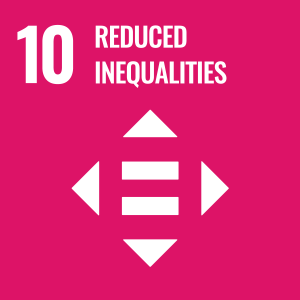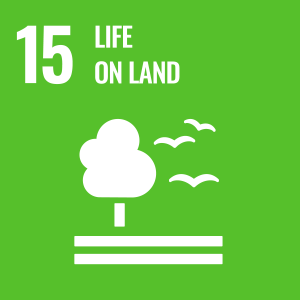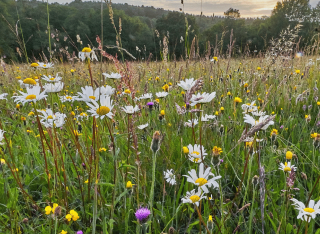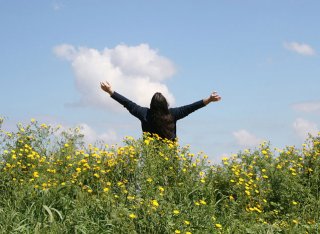
Dr Melissa Marselle
Academic and research departments
Environmental Psychology Research Group (EPRG), School of Psychology, Faculty of Health and Medical Sciences.About
Biography
Dr Melissa Marselle is a Lecturer in Environmental Psychology. She is recognised internationally as an expert researcher on the mental health benefits of biodiverse natural environments. She is also acknowledged for her work to mitigate the biodiversity crisis using behaviour change theory, for which she was contributing author to the IPBES Values Assessment. Over 15+ years of interdisciplinary research, she has published 50 research papers and book chapters, mostly exploring how contact with biodiverse natural environments fosters wellbeing.
She has given talks and hosted seminars and workshops with academic, practitioner, and public audiences across the UK and Europe, and in Canada, China and USA, as well as the IUCN Working Group on Ecosystems and Human Health. As of September 2025, her work has been cited over 4,000 times, including in 100 policy documents. I am a co-author of the WHO Europe report on the mental health benefits of green and blue spaces. My framework on biodiversity and health linkages has been cited by the World Health Organization, the Government of Finland, and others. My research on street trees and antidepressant prescriptions has informed reports by the UN Environment Programme and the European Environment Agency, among several international bodies.
Dr Marselle is co-Chair of the Environmental Psychology Section of the British Psychological Society. She holds editorial board positions on the British Ecological Society journal People and Nature, and British Psychological Society journal Environmental Psychology Research.
--
She gained a BA in Psychology at Oregon State University (USA)(1999-2003) before moving to the UK to complete a Master’s degree in Environmental Psychology at the University of Surrey (2003-2004) and a PhD in Environmental Psychology from De Montfort University (2010-2014). Her PhD, supervised by Dr Katherine Irvine and Prof Sara Warber, MD, investigated the psychological well-being benefits of group walks in nature, with a particular focus on the Ramblers’ Wellbeing Walks programme.
Melissa has nearly 20 years’ experience as an interdisciplinary researcher. She worked closely with ecologists to investigate the mental health benefits of biodiversity at the Biodiversity & People Department, Helmholtz Centre for Environmental Research – UFZ and the German Centre for Integrative Biodiversity Research (iDiv) (2017-2020). She investigated implicit and explicit attributes to climate change with Prof Geoff Beattie at the Department of Psychology, Edge Hill University (2014-2015), investigating university student safety and well-being at the School of Arts & Media, University of Salford (2015-2017). She worked with Greater Manchester Police and Manchester City Council to design out crime in Manchester city centre, as a research fellow at the University of Salford (2007-2010). She combined environmental psychology with design thinking on the ‘Positive Soundscapes’ project. She worked with fire safety engineers as a research assistant on the World Trade Centre 9/11 Evacuation Study at the University of Liverpool (2004-2007).
Melissa worked as a Lecturer in Psychological Well-being at De Montfort University in 2020-21. She joined the University of Surrey in April 2021.
Areas of specialism
My qualifications
Affiliations and memberships
News
In the media
ResearchResearch interests
My research focuses on the health benefits of nature and biodiversity, as well as the psychology of sustainability.
Health benefits of nature and biodiversity
There is considerable evidence that contact with nature can benefit human health and wellbeing. But less is known about which types and qualities of nature influence health. Such information would help urban planners and public health professionals to plan, manage and prescribe urban green space as a nature-based intervention to improve human health.
My research addresses questions such as:
- Which types of green and blue spaces influence mental health and well-being?
- What are the mental health benefits of biodiversity?
- How does nature and biodiversity influence human health? What are the mediating pathways?
- Does this the best ‘dose’ of nature for a positive benefit?
- Do the ways in which we experience nature or biodiversity (e.g. visual or auditory, indirect or direct, incidentally or intentionally) influence our outcomes?
- Environmental neuroscience – how does the brain react to biodiversity?
The psychology of sustainability
Nature and biodiversity are crucial for human health and wellbeing. But biodiversity is declining at an unprecedented rate, threatening the human health. As human activities are responsible for biodiversity loss and climate change, the solution to biodiversity conservation and climate change mitigation lies in transformative changes in people's behaviour. But the behavioural sciences are rarely used in conservation research. Consequently, behaviour change interventions for nature conservation, and ambitious international conservation policies, often fail because they are poorly informed by behavioural change theory.
My research addresses questions such as:
- Why do national and international sustainability polices fail to achieve their goal?
- What behaviour change interventions are included in national and international sustainability polices? Are key interventions known from psychology to be effective being under-used? Are less effective interventions being overused?
- How can national and international sustainability polices be improved through the use of psychological theory?
Research projects
Dr. FOREST aims to:
- Study the effects and underlying mechanisms with which tree diversity in temperate forests influences human health and well-being;
- Understand and predict the effects of global climate change, air pollution and other change factors on biodiversity-related health issues;
- Evaluate and define tree diversity benefits to human health and well-being, and communicate these findings to local and high-level international stakeholders.
For several years, papers have been published about the positive impact of greenness on health, including some synthesis and systematic reviews. Yet, none of them has so far addressed the question of the type of habitats and components that have a significant (and preferably positive) effect on mental health and well-being. This is important in order to provide recommendations to designers and managers of green and blue space in and around cities.
An Expert Working Group conducted two systematic reviews (blue and green) to answer this question.
Research collaborations
Dr Katherine Irvine, The James Hutton Institute, UK
Prof. Sara Warber, University of Michigan, USA
Prof. Aletta Bonn, Helmholtz Centre for Environmental Research, Germany
Dr Agathe Colleony & Dr Assaf Shwartz, Technion Institute of Technology, Israel
Indicators of esteem
Co-chair of the British Psychological Society's Environmental Psychology Section
Associate Editor of Environmental Psychology Research
Associate Editor of People and Nature
Research interests
My research focuses on the health benefits of nature and biodiversity, as well as the psychology of sustainability.
Health benefits of nature and biodiversity
There is considerable evidence that contact with nature can benefit human health and wellbeing. But less is known about which types and qualities of nature influence health. Such information would help urban planners and public health professionals to plan, manage and prescribe urban green space as a nature-based intervention to improve human health.
My research addresses questions such as:
- Which types of green and blue spaces influence mental health and well-being?
- What are the mental health benefits of biodiversity?
- How does nature and biodiversity influence human health? What are the mediating pathways?
- Does this the best ‘dose’ of nature for a positive benefit?
- Do the ways in which we experience nature or biodiversity (e.g. visual or auditory, indirect or direct, incidentally or intentionally) influence our outcomes?
- Environmental neuroscience – how does the brain react to biodiversity?
The psychology of sustainability
Nature and biodiversity are crucial for human health and wellbeing. But biodiversity is declining at an unprecedented rate, threatening the human health. As human activities are responsible for biodiversity loss and climate change, the solution to biodiversity conservation and climate change mitigation lies in transformative changes in people's behaviour. But the behavioural sciences are rarely used in conservation research. Consequently, behaviour change interventions for nature conservation, and ambitious international conservation policies, often fail because they are poorly informed by behavioural change theory.
My research addresses questions such as:
- Why do national and international sustainability polices fail to achieve their goal?
- What behaviour change interventions are included in national and international sustainability polices? Are key interventions known from psychology to be effective being under-used? Are less effective interventions being overused?
- How can national and international sustainability polices be improved through the use of psychological theory?
Research projects
Dr. FOREST aims to:
- Study the effects and underlying mechanisms with which tree diversity in temperate forests influences human health and well-being;
- Understand and predict the effects of global climate change, air pollution and other change factors on biodiversity-related health issues;
- Evaluate and define tree diversity benefits to human health and well-being, and communicate these findings to local and high-level international stakeholders.
For several years, papers have been published about the positive impact of greenness on health, including some synthesis and systematic reviews. Yet, none of them has so far addressed the question of the type of habitats and components that have a significant (and preferably positive) effect on mental health and well-being. This is important in order to provide recommendations to designers and managers of green and blue space in and around cities.
An Expert Working Group conducted two systematic reviews (blue and green) to answer this question.
Research collaborations
Dr Katherine Irvine, The James Hutton Institute, UK
Prof. Sara Warber, University of Michigan, USA
Prof. Aletta Bonn, Helmholtz Centre for Environmental Research, Germany
Dr Agathe Colleony & Dr Assaf Shwartz, Technion Institute of Technology, Israel
Indicators of esteem
Co-chair of the British Psychological Society's Environmental Psychology Section
Associate Editor of Environmental Psychology Research
Associate Editor of People and Nature
Teaching
I largely teach on the MSc Environmental Psychology programme. I teach about the health benefits of nature in the module 'Key Questions in Environmental Psychology' (PSY3072/PSYM137), the Behaviour Change Wheel in 'Psychology of Sustainable Development' (PSYM067), and design against crime on 'Psychology of Planning and Architecture' module. I also teaching on the module 'Psychology of Global Challenges' (PSY1033).
I am the Dissertation Tutor for the Psychology Undergraduate Dissertation (PSY3065).
Sustainable development goals
My research interests are related to the following:





Publications
Highlights
2025
Gillerot, Landuyt, Bourdin, Rozario, Shaw, Steinparzer, Stojek, Vanroy, Cuentas Romero, Müller, Oh, Proß, Bonal, Bonn, Bruelheide, Godbold, Haluza, Jactel, Jaroszewicz, Kilpi, Marselle, Ponette, Scherer-Lorenzen, De Frenne, Muys & Verheyen (2025) Forest biodiversity and structure modulate human health benefits and risks. Nature Sustainability, 8, 485–497.
Rozario*, Shaw*, Marselle, Oh, Schröger, Giraldo Botero, Frey, Ștefan, Müller, Scherer-Lorenzen, Jaroszewicz, Verheyen, & Bonn (2025) Perceived biodiversity: Is what we measure also what we see and hear? People and Nature
Azad, S., & Marselle, M. (2025) Thriving Through Stressful Life Events with Nature: A Mixed-Method Study on Tending Indoor Plants and Rumination Resilience. International Journal of Environmental Research and Public Health 22 (3), 369
Kondo, Adlakha, Marselle, Odell, Olcon, Deutsch, Feng, & Astell-Burt. (2025) Barriers to Participation in Nature Prescriptions: Evidence From a Cross‐Sectional Survey of Adults in Australia, India, Singapore, the United Kingdom, and the United States. Health & Social Care in the Community, Vol 2025, 6635387
Uebel, K., Bonn, A., Marselle, M., Dean, A., &. Rhodes, J. (2025) Understory vegetation can promote bird sounds and reduce traffic noise in urban park soundscapes. Urban Ecosystems 28 (2), 1-12
Wendelboe-Nelson … Oh*, Bonn* & Marselle* (2025) Outdoor health intervention for refugees, migrants, and asylum-seekers: A mixed-methods pilot study. Health & Place.
de Bell … Marselle*, Oh* & Bonn* (2024). Nature-based social prescribing programmes: opportunities, challenges, and facilitators for implementation. Environment International
2024
de Bell … Marselle*, Oh* & Bonn* (2024). Nature-based social prescribing programmes: opportunities, challenges, and facilitators for implementation. Environment International
Rozario, Oh, Marselle … & Bonn (2024). The more the merrier? Perceived forest biodiversity promotes short-term mental health and well-being—A multicentre study. People and Nature
Rode, Moreno Soares, Colléony, Turbe, Chadwick & Marselle (2024). National biodiversity strategies under-utilize the potential for individual behavior change. Environmental Science & Policy
Rouet-Ludec, van der Plas, Bonn, Helmer, Marselle, von Essen & Pe’er (2024). Exploring the motivation and challenges for land-users engaged in sustainable grazing in Europe. Land Use Policy
Felipe-Lucia, de Frutos, Crouzat, Grescho, Heuschele, Marselle … & Bonn. (2024) Differences in the experience of cultural ecosystem services in mountain protected areas by clusters of visitors. Ecosystem Services
2023
Beute*, Marselle* … & de Vries. (2023). How do different types and characteristics of green space impact mental health? A scoping review. People and Nature.
Astell-Burt, Hipp, Gatersleben, Adlakha, Marselle … & Feng. (2023). Need and interest in nature prescriptions to protect cardiovascular and mental health: A nationally-representative study with insights for future randomised trials. Heart, Lung and Circulation, 32
2022
Irvine, K.N., Fisher, D., Marselle, M.R, Currie, M., Colley, K., & Warber, S.L. (2022). Social Isolation of Older Adults: A qualitative study of the effects of group outdoor health walks on social wellbeing. International Journal of Environmental Research and Public Health, 19(9), 5353. https://doi.org/10.3390/ijerph19095353
2021
Perino, A., Pereira, H.M., Felipe-Lucia, M., Kim, H., Kuehl, H., Marselle, M … & Bonn, A. (2021) Biodiversity Post-2020: Closing the gap between global targets and national-level implementation. Conservation Letters, e12848. DOI: 10.1111/conl.12848
Richter, A., Comay, O., Svenningsen, C.S., Coilling Larsen, C., Hecker, S., Tottrup, A.P., Pe’er, G., Dunn, R.R., Bonn, A., & Marselle, M.R. (2021). Motivation and support in citizen science insect monitoring: A cross-country study. Biological Conservation, 263, 109325. https://doi.org/10.1016/j.biocon.2021.109325
Uebel, K., Marselle, M., Dean, A.J., Rhodes, J., & Bonn, A. (2021). Urban green space soundscapes and their perceived restorativeness. People and Nature 3 (3), 756-769. https://doi.org/10.1002/pan3.10215
Marselle, M.R, Lindley, S.J., Cook, P.A. & Bonn, A. (2021). Biodiversity and Health in the Urban Environment. Current Environmental Health Reports, 8, 146-156. https://doi.org/10.1007/s40572-021-00313-9
Marselle, M., Hartig, T., Cox, D.T.C., de Bell, S., Knapp, S., Lindley, S., Triguero-Mas, M. ... & Bonn, A. (2021). Pathways linking biodiversity to human health: A conceptual framework. Environment International, 150, 106420. https://doi.org/10.1016/j.envint.2021.106420
Methorst, J., Bonn, A., Marselle, M., Böhning-Gaese, K., & Rehdanz, K. (2021). Species richness is positively related to mental health – A study for Germany. Landscape and Urban Planning, 211, 104084. https://doi.org/10.1016/j.landurbplan.2021.104084
2020
Marselle, M.R., Bowler, D.E., Watzema, J., Eichenberg, D., Kirsten, T., & Bonn, A. (2020). Urban street tree biodiversity and antidepressant prescriptions. Scientific Reports, 10, 22445. https://doi.org/10.1038/s41598-020-79924-5
Marselle, M.R., Turbe, A., Shwartz, A., Bonn, A., & Colléony, A. (2020). Addressing behavior in pollinator conservation policies to combat the implementation gap.
Conservation Biology, 35, 610-622. https://doi.org/10.1111/cobi.13581
Irvine, K.N., Marselle, M.R., Melrose, A., & Warber, S.L (2020). Group Outdoor Health Walks Using Activity Trackers: Measurement and Implementation Insight from a Mixed Methods Feasibility Study.
International Journal of Environmental Research and Public Health, 17, 2515. https://doi.org/10.3390/ijerph17072515
Edited Books
Marselle, M.R., Stadler, J., Korn, H., Irvine, K.N., & Bonn, A. (Eds). Biodiversity and Health in the Face of Climate Change. Springer Nature. https://doi.org/10.1007/978-3-030-02318-8
Book chapters
Marselle, M.R. (2019). Theories of biodiversity and mental health and well-being relationships. In: Marselle, Stadler, Korn, Irvine and Bonn (Eds). Biodiversity and Health in the Face of Climate Change, Springer Nature.
Marselle, M.R, Martens, D., Dallimer, M., & Irvine, K.N. (2019). Review of the mental health and well-being benefits of biodiversity. In: Marselle, Stadler, Korn, Irvine and Bonn (Eds). Biodiversity and Health in the Face of Climate Change, Springer Nature.
Marselle, M.R, Stadler, J. Horst, K., Irvine, K.N. & Bonn, A. (2019). Biodiversity and health in the face of climate change - Perspectives for science, policy and practice. In: Marselle, Stadler, Korn, Irvine and Bonn (Eds). Biodiversity and Health in the Face of Climate Change, Springer Nature.
The benefits and risks of forests to human health are widely recognized. Yet, variation across forest types and their ecological characteristics driving health effects remain underexplored. Based on a continental-scale, interdisciplinary empirical database from 164 European forest stands, we constructed a Bayesian Belief Network to quantify seven causal pathways relating distinct forest types to physical and mental health. These forest–health pathways included mental well-being via visual or auditory stimuli, thermal comfort, polyphenol content of medicinal plants, mushrooms and nutrition, air quality, and ticks and Lyme disease. Results show that forests consistently provide net health benefits regardless of their ecological characteristics. Forest canopy density and tree species diversity emerge as key drivers, but their effect size and directionality are strongly pathway-dependent. Changes in forest canopy density can generate trade-offs. For example, forests optimized for heat buffering and air pollution mitigation may compromise medicinal plant yield and enhance Lyme disease prevalence. Tree diversity effects were weaker but more uniformly positive. Therefore, forest management should account for such trade-offs to tailor forest biodiversity and functioning to local public health priorities.
Biodiversity is crucial for human health and well-being. Perceived biodiversity—people's subjective experience of biodiversity—seems to be particularly relevant for mental well-being.
Using photographs and audio recordings of forests that varied in levels of biodiversity, we conducted two sorting studies to assess how people perceive visual and acoustic diversity and whether their perceptions align with species richness and proxies for forest structural diversity (‘actual diversity’). Per study, 48 participants were asked to sort the stimuli according to any similarity-based sorting criteria they liked (‘open sorts’) and perceived diversity (‘closed sorts’).
The main perceived visual forest characteristics identified by participants in the open visual sorts were vegetation density, light conditions, forest structural attributes and colours. The main perceived acoustic forest characteristics identified in the open acoustic sorts comprised bird song characteristics, physical properties such as volume, references to the time of day or seasonality and evoked emotions.
Perceived visual and acoustic diversity were significantly correlated with actual visual and acoustic diversity, respectively.
We further computed several objective visual and acoustic diversity indices from the photos and audio recordings, for example, a Greenness Index or the Acoustic Complexity Index, and assessed their relevance for perceived and actual diversity. While all acoustic diversity indices were significantly associated with perceived and actual acoustic diversity, for the visual sense, the Greenness Index successfully captured both perceived and actual visual diversity.
Our results suggest that people can perceive variations in biodiversity levels. Our identified visual and acoustic forest characteristics may help to better understand perceived diversity and how it differs from how diversity is measured in biological studies. We present one visual and several acoustic diversity indices that quantify aspects of perceived and actual diversity. These indices may serve as cost-efficient tools to manage and plan greenspaces to promote biodiversity and mental well-being.
Soundscapes from natural areas are an important cultural ecosystem service that can promote greater mental health and well-being. However, the mediating pathways by which this occurs are not yet fully understood, limiting their integration into ecosystem service frameworks. We addressed this gap by examining a range of mediating pathways between subjective and objective measures of natural soundscapes and well-being. Using online surveys, a representative UK sample (N = 1529) listened to simulated natural soundscapes with differing levels of three acoustic metrics. Participants completed measures of subjective well-being and perceived restoration, along with perceptions of bird diversity within soundscapes, restorativeness, stress and awe. Structural equation modelling was then used to test the theoretically-indicated pathways between subjective and objective measures of the soundscapes and well-being. Results confirmed biodiversity-health hypotheses: the relationship between perceived bird diversity and well-being was mediated by greater perceived restorative qualities of the soundscape, reduced perceived stress and greater perceptions of awe. Novel mechanistic pathways between acoustic characteristics and well-being were also demonstrated with moderate to high acoustic complexity displaying an indirect effect on well-being via serial mediation pathways: first through higher perceived biodiversity levels, and then either greater perceived restorativeness, reduced perceived stress or increased awe. These results provide new insights into how natural soundscapes can deliver well-being benefits and can inform the management and valuation of soundscapes in natural areas.
Natural soundscapes commonly experienced in parks are increasingly valued as an important cultural ecosystem service with the potential to promote greater mental well-being for people. Yet the quality of urban park soundscapes can differ, containing varying proportions of natural sounds, such as bird calls, and anthropogenic noise, such as vehicle traffic. These soundscapes are linked to underlying landscape features yet their role in shaping both beneficial natural sounds and unwanted anthropogenic noise remains unclear. We address this gap by analysing the influence of park and surrounding landscape characteristics on a range of urban park soundscapes in Brisbane, Australia, with respect to bird sounds and traffic noise. We recorded audio in 67 parks in Brisbane, Australia and quantified bird call volume, bird call diversity and traffic noise volume for each recording. We then used multiple linear regression analyses to determine the influence of land cover classes, vertical vegetation density and distance to a main road on each of these dimensions. We show that greater vegetation density in the understory has a positive influence on the loudness and diversity of bird calls within park soundscapes and a negative influence on traffic noise. Traffic noise was also associated with greater proximity to a main road and higher canopy height, whilst greater impervious surface appeared to increase the dominant sound type (i.e. either bird sounds or traffic noise) within the soundscape. These findings highlight the importance of managing the landscape features of urban parks to promote higher quality soundscapes. Results suggest that greater vegetation density and complexity, particularly in the understory, has potential as a nature-based solution to enhance the diversity of bird calls within park soundscapes whilst also mitigating traffic noise.
Cities, states, and countries across the globe are recognizing the interconnections of human and planetary health, and are investing in greening. Nevertheless, environmental improvements may not bring adequate changes in exposure needed to reduce chronic disease and improve mental health. Nature prescription, in which a health provider refers a patient to spend time outdoors, is a potential behavioral intervention that could connect people to accessible green spaces. However, formidable patient barriers could reduce the potential to scale-up implementation in equitable and sustained ways. We surveyed 2625 adult respondents within Australia, India, Singapore, the United States, and the United States about their perceptions of a set of seven potential barriers to participation in nature prescriptions. Analyses revealed that respondents in India and Singapore, although most aware of and experienced with nature prescriptions, reported facing greater barriers than in other countries. Weather was the most commonly reported barrier, followed by the lack of time and distance. A lack of interest was a greater barrier among young, urban respondents with a college degree. The barrier of the lack of company was greater for urban residents and for those experiencing financial difficulty. In addition, contrary to many prior studies, we observed greater overall perceived barriers for respondents with higher education levels. Many of the perceived barriers covered by our survey are structurally modifiable, and programs developing in each of these locations may draw from these findings to tailor outreach strategies.
Stressful life events are often undesirable, inevitable, and significant changes in one’s life, often triggering rumination and posing risks to mental health. However, these risks can be managed through coping strategies. Contact with nature has been shown to reduce rumination and enhance mental well-being.
The current study investigated the effectiveness of a one-month nature-based intervention in enhancing psychological well-being and building resilience to manage rumination following a stressful life event. In this mixed-method study, 26 participants were randomly allocated to either an experimental group (n = 13), which tended to the Zamioculcas zamiifolia indoor plant for one month, or a waitlist control group (n = 13). Quantitative findings showed that tending to indoor plants was significantly effective in reducing depressive symptoms (p = 0.003), perceived stress (p < 0.001), negative affect (p = 0.017), and rumination (p = 0.015), as well as in enhancing resilience (p = 0.03) compared to the control group post-intervention.
Qualitative findings provided insight into how the nature-based intervention fosters rumination resilience, the mediating effects of tending to an indoor plant, and the contribution it makes to psychological well-being. ‘Offers a slice of nature by bringing the outside, in’ demonstrates how caring for indoor plants creates a bridge for connection with nature. ‘Fosters an emotionally regulating personal sanctuary’ captures how tending to indoor plants can help manage emotions and provide a sense of empowerment that helps mitigate the tendency to ruminate. ‘Plants seeds for improving self-care, personal growth and introspection’ highlights indoor plants as a symbolic representation of resilience and renewal. A narrative emerges: as indoor plants grow and thrive with attention, so too does the individual, forming a deep, reciprocal relationship between nature and personal well-being.
This study demonstrates nature’s role in coping with stressful life events and developing rumination resilience, paving the way for further research to explore its caveats and refine and expand nature-based interventions.
Despite the multifaceted and diverse challenges that refugees, migrants, and asylum-seekers experience when entering a new country, they remain notably underrepresented in the evaluation and understanding of the health and wellbeing impacts of outdoor health interventions. We addressed this knowledge gap by a mixed-methods evaluation (questionnaires, focus groups and photo elicitation activity) facilitated by a community researcher. Qualitative data (focus groups and photo elicitation activity) revealed that the participants saw the social component of outdoor activities as a critical factor in improving their wellbeing, an insight not captured by established quantitative wellbeing scales. Given the diverse backgrounds of refugee, migrant, and asylum-seeker populations, we underline the importance of a transdisciplinary, collaborative, and mixed-methods research approach.
Background
Evidence on the health benefits of spending time in nature has highlighted the importance of provision of blue and green spaces where people live. The potential for health benefits offered by nature exposure, however, extends beyond health promotion to health treatment. Social prescribing links people with health or social care needs to community-based, non-clinical health and social care interventions to improve health and wellbeing. Nature-based social prescribing (NBSP) is a variant that uses the health-promoting benefits of activities carried out in natural environments, such as gardening and walking. Much current NBSP practice has been developed in the UK, and there is increasing global interest in its implementation. This requires interventions to be adapted for different contexts, considering the needs of populations and the structure of healthcare systems.
Methods
This paper presents results from an expert group participatory workshop involving 29 practitioners, researchers, and policymakers from the UK and Germany’s health and environmental sectors. Using the UK and Germany, two countries with different healthcare systems and in different developmental stages of NBSP practice, as case studies, we analysed opportunities, challenges, and facilitators for the development and implementation of NBSP.
Results
We identified five overarching themes for developing, implementing, and evaluating NBSP: Capacity Building; Accessibility and Acceptability; Networks and Collaborations; Standardised Implementation and Evaluation; and Sustainability. We also discuss key strengths, weaknesses, opportunities, and threats for each overarching theme to understand how they could be developed to support NBSP implementation.
Conclusions
NBSP could offer significant public health benefits using available blue and green spaces. We offer guidance on how NBSP implementation, from wider policy support to the design and evaluation of individual programmes, could be adapted to different contexts. This research could help inform the development and evaluation of NBSP programmes to support planetary health from local and global scales.
Forests can foster mental health and well-being. Yet, the contribution of forest biodiversity remains unclear, and experimental research is needed to unravel pathways of biodiversity–health linkages. Here, we assess the role of tree species richness, both actual and perceived, and how stress reduction and attention restoration can serve as potential mediating pathways to achieve positive mental health and well-being outcomes.
We conducted an experimental, multicentric field study in three peri-urban forests in Europe, employing a mixed design with 223 participants, that comprised 20-min stays in forests with either low, medium or high tree species richness or a built control. Participants' short-term mental health and well-being and saliva cortisol as a biomarker of stress were measured before and after the intervention.
Forest visits for 20 min were found to be beneficial for participants' short-term mental health, short-term mental well-being, subjective stress, subjective directed attention and perceived restorativeness compared with a built environment. No differences were found for the physiological stress indicator saliva cortisol, which decreased in both the forest and the built environments.
Increased perceived biodiversity—possibly linked to structural forest attributes—was significantly associated with well-being outcomes, while no association was found for differences in actual tree species richness. Structural equation modelling indicates that higher levels of perceived biodiversity had an indirect effect on short-term mental health and well-being through enhancing perceived restorativeness.
While we found no evidence of actual tree species richness effects, perceived biodiversity was associated with positive short-term mental health and well-being outcomes. Understanding these biodiversity–health linkages can inform conservation management and help develop effective nature-based interventions for promoting public health through nature visits.
In Green and blue spaces and mental health: new evidence and perspectives for action. Copenhagen: WHO Regional Office for Europe.
People and Nature, 3, 756-769
Current Environmental Health Reports, 8, 146–156
Purpose of review Biodiversity underpins urban ecosystem functions that are essential for human health and well-being. Understanding how biodiversity relates to human health is a developing frontier for science, policy and practice. This article describes the beneficial, as well as harmful, aspects of biodiversity to human health in urban environments.
Recent findings Recent research shows that contact with biodiversity of natural environments within towns and cities can be both positive and negative to human physical, mental and social health and well-being. For example, while viruses or pollen can be seriously harmful to human health, biodiverse ecosystems can promote positive health and well-being. On balance, these influences are positive. As biodiversity is declining at an unprecedented rate, research suggests that its loss could threaten the quality of life of all humans.
Summary A key research gap is to understand—and evidence—the specific causal pathways through which biodiversity affects human health. A mechanistic understanding of pathways linking biodiversity to human health can facilitate the application of nature-based solutions in public health and influence policy. Research integration as well as cross-sector urban policy and planning development should harness opportunities to better identify linkages between biodiversity, climate and human health. Given its importance for human health, urban biodiversity conservation should be considered as public health investment.
Environment International, 150, 106420.
Biodiversity is a cornerstone of human health and well-being. However, while evidence of the contributions of nature to human health is rapidly building, research into how biodiversity relates to human health remains limited in important respects. In particular, a better mechanistic understanding of the range of pathways through which biodiversity can influence human health is needed. These pathways relate to both psychological and social processes as well as biophysical processes. Building on evidence from across the natural, social and health sciences, we present a conceptual framework organizing the pathways linking biodiversity to human health. Four domains of pathways—both beneficial as well as harmful—link biodiversity with human health: (i) reducing harm (e.g. provision of medicines, decreasing exposure to air and noise pollution); (ii) restoring capacities (e.g. attention restoration, stress reduction); (iii) building capacities (e.g. promoting physical activity, transcendent experiences); and (iv) causing harm (e.g. dangerous wildlife, zoonotic diseases, allergens). We discuss how to test components of the biodiversity-health framework with available analytical approaches and existing datasets. In a world with accelerating declines in biodiversity, profound land-use change, and an increase in non-communicable and zoonotic diseases globally, greater understanding of these pathways can reinforce biodiversity conservation as a strategy for the promotion of health for both people and nature. We conclude by identifying research avenues and recommendations for policy and practice to foster biodiversity-focused public health actions.
Landscape and Urban Planning, 211, 104084.
Nature benefits human health. To date, however, little is known whether biodiversity relates to human health. While some local and city level studies show that species diversity, as a measure of biodiversity, can have positive effects, there is a lack of studies about the relationship between different species diversity measures and human health, especially at larger spatial scales. Here, we conduct cross-sectional analyses of the association between species diversity and human health across Germany, while controlling for socio-economic factors and other nature characteristics. As indicators for human health, we use the mental (MCS) and physical health (PCS) component scales of the German Socio-Economic Panel (SOEP, Short Form Health Questionnaire – SF12). For species diversity, we use species richness and abundance estimates of two species groups: plants and birds. We phrase the following hypotheses: plant and bird species are positively associated with mental and physical health (H1 & H3); bird abundance is positively related to mental health (H2). Our results demonstrate a significant positive relationship between plant and bird species richness and mental health across all model variations controlling for a multitude of other factors. These results highlight the importance for species diversity for people’s mental health and well-being. Therefore, policy makers, landscape planners and greenspace managers on the local and national level should consider supporting biodiverse environments to promote mental health and wellbeing. For this purpose, we propose to use species diversity measures as indicators for salutogenic (health promoting) characteristics of nature, landscape and urban green space
Scientific Reports, 10, 22445.
Growing urbanisation is a threat to both mental health and biodiversity. Street trees are an important biodiversity component of urban greenspace, but little is known about their effects on mental health. Here, we analysed the association of street tree density and species richness with antidepressant prescribing for 9751 inhabitants of Leipzig, Germany. We examined spatial scale effects of street trees at different distances around participant’s homes, using Euclidean buffers of 100, 300, 500, and 1000 m. Employing generalised additive models, we found a lower rate of antidepressant prescriptions for people living within 100 m of higher density of street trees—although this relationship was marginally significant (p = 0.057) when confounding factors were considered. Density of street trees at further spatial distances, and species richness of street trees at any distance, were not associated with antidepressant prescriptions. However, for individuals with low socio-economic status, high density of street trees at 100 m around the home significantly reduced the probability of being prescribed antidepressants. The study suggests that unintentional daily contact to nature through street trees close to the home may reduce the risk of depression, especially for individuals in deprived groups. This has important implications for urban planning and nature-based health interventions in cities.
Conservation Biology, 35(2), 610-622.
Solutions for conserving biodiversity lie in changing people's behavior. Ambitious international and national conservation policies frequently fail to effectively mitigate biodiversity loss because they rarely apply behavior‐change theories. We conducted a gap analysis of conservation behavior‐change interventions advocated in national conservation strategies with the Behavior Change Wheel (BCW), a comprehensive framework for systematically characterizing and designing behavior‐change interventions. Using pollinator conservation as a case study, we classified the conservation actions listed in national pollinator initiatives in relation to intervention functions and policy categories of the BCW. We included all national‐level policy documents from the European Union available in March 2019 that focused on conservation of pollinators (n = 8). A total of 610 pollinator conservation actions were coded using in‐depth directed content analysis, resulting in the identification of 787 intervention function and 766 policy category codes. Overall, these initiatives did not employ the entire breadth of behavioral interventions. Intervention functions most frequently identified were education (23%) and environmental restructuring (19%). Least frequently identified intervention functions were incentivization (3%), and restriction (2%) and coercion were completely absent (0%). Importantly, 41% of all pollinator conservation actions failed to identify whose behavior was to be changed. Building on these analyses, we suggest that reasons for the serious implementation gap in national and international conservation policies is founded in insufficient understanding of which behavioral interventions to employ for most beneficial impacts on biodiversity and how to clearly specify the intervention targets. We recommend that policy advisors engage with behavior‐change theory to design effective behavior‐change interventions that underpin successful conservation policies.
International Journal of Environmental Research and Public Health, 17(7).
Outdoor walking groups are nature-based interventions (NBIs) that promote health and wellbeing by modifying individual behaviour. The challenges of such NBIs include the motivation of inactive adults to participate and measurement issues. This feasibility study investigates a 12-week group outdoor health walk (GOHW) incorporating activity trackers and use of a holistic health and wellbeing measure, the Self-sasessment of Change (SAC) scale. A mixed methods design explored participant recruitment and retention, programme delivery, and measures of physical activity and health and wellbeing. Walker data included: pre-post questionnaires, daily step counts, and interviews. Programme delivery information included: weekly checklists, staff reflections, stakeholder meeting minutes, and a report. Thirteen adults (age 63–81, 76% female) joined and completed the activity tracker GOHW. Activity trackers motivated walkers to join and be more active but complicated programme delivery. Activity trackers allowed the quantification of physical activity and the SAC health and wellbeing measure was easy to use. By week 12, all participants met national physical activity guidelines. Clinically relevant changes on the SAC scale included: sleeping well, experiencing vibrant senses, and feeling energised, focused, joyful, calm and whole. Results illustrate the feasibility of using activity trackers to motivate engagement in and provide a measure of physical activity from GOHWs. The SAC scale offers a promising measure for nature–health research. A conceptual model is provided for the development of future large-scale studies of NBIs, such as group outdoor health walks
Sustainability Science, 14, 1717–1728.
In this paper, we investigate the cogency of the “sustainability or collapse” narrative, that is, the notion that the current global civilization risks ecological overshoot-induced collapse. Combining different strands of literature, we put forward three arguments: First, for many empirical cases of past societies that purportedly “collapsed”, alternative interpretations, emphasizing resilience, transformation and reorganization are equally if not more plausible. Second, the “sustainability or collapse” narrative tends to be misleading insofar as it suggests that resource input constraints are the main sustainability challenge global civilization faces today. Instead, we argue that a stronger focus on system outputs and pollution is needed. Third, collapse-warnings are psychologically ineffective because they might induce fear and guilt, which leads to apathy not action. In consequence, we suggest that the sustainability agenda relies on positive framings that highlight the benefits from institutional and behavioral changes for human well-being. We illustrate our argument with two examples, water scarcity in Cape Town, South Africa and the German energy transition.
International Journal of Environmental Research and Public Health, 16(6).
Nature-based activities have been used as therapeutic interventions for those experiencing stress and mental ill health. This study investigates whether group walks could be a nature-based intervention to foster resilience, by buffering the effects of recent stressful life events on mental health. An observational research design with propensity score-matched samples compared the mental health of individuals who did (Nature Group Walkers, n = 1081) or did not (Non-Group Walkers, n = 435) attend nature group walks. A sub-sample of Frequent Nature Group Walkers (at least once per week, n = 631) was also investigated. Data were analyzed using multiple regression with an interaction term. All analyses were controlled for age, gender, and recent physical activity. Results showed that neither nature group walking, nor doing this frequently, moderated the effects of stressful life events on mental health. Using a main effects model, the positive associations of group walks in nature were at a greater magnitude than the negative associations of stressful life events on depression, positive affect, and mental well-being, suggesting an ‘undoing’ effect of nature group walks. Group walking schemes in natural environments may be an important public health promotion intervention for mental health
Springer Nature: Cham, Switzerland.
This edited open access book identifies and discusses biodiversity’s contribution to physical, mental and spiritual health and wellbeing. Furthermore, the book identifies the implications of this relationship for nature conservation, public health, landscape architecture and urban planning – and considers the opportunities of nature-based solutions for climate change adaptation.
This transdisciplinary book will attract a wide audience interested in biodiversity, ecology, resource management, public health, psychology, urban planning, and landscape architecture. The emphasis is on multiple human health benefits from biodiversity - in particular with respect to the increasing challenge of climate change. This makes the book unique to other books that focus either on biodiversity and physical health or natural environments and mental wellbeing. The book is written as a definitive ‘go-to’ book for those who are new to the field of biodiversity and health.
In: Marselle, Stadler, Korn, Irvine and Bonn (Eds). Biodiversity and Health in the Face of Climate Change. Springer Nature.
In: Marselle, Stadler, Korn, Irvine and Bonn (Eds). Biodiversity and Health in the Face of Climate Change. Springer Nature.
In: Marselle, Stadler, Korn, Irvine and Bonn (Eds). Biodiversity and Health in the Face of Climate Change. Springer Nature.
Studies in Higher Education, 44(11), 1931-1944.
Semiotica, 218, 21-64.
Energy Research & Social Science, 19, 177-191.
Improving the design and implementation of interventions to encourage end-use energy efficiency has the potential to contribute a substantive reduction in carbon emissions. A plethora of behaviour change frameworks is available to guide policymakers and designers but none have been found to be comprehensive or well-used. A new framework – the Behaviour Change Wheel (BCW) – purports to be a useful aid for developing all types of behaviour change interventions. This paper assesses whether the BCW comprehensively describes programmes attempting to reduce energy consumption. To do this, components of behaviour change programmes as identified in four EU guidance documents were mapped onto the BCW. Most of the components discussed in the guidance could be readily coded to the BCW framework. The main energy policy under-represented in the BCW was energy price. Based on our work in this paper, we believe that the BCW offers a useful aid for the systematic design and development of behaviour change around end-use energy efficiency. We also propose that it may support development of a common lexicon for activities that can be rather vaguely described currently in energy efficiency guidance.
Journal of Environmental Psychology, 46, 217-232.
Natural environments are associated with positive health and well-being. However, little is known about the influence of environmental qualities on well-being and the mechanisms underlying this association. This study explored whether perceived restorativeness and it subscales would mediate the effects of perceived biodiversity, perceived naturalness, walk duration and perceived intensity on emotional well-being.
Participants (n = 127) of a national walking program in England completed pre- and post-walk questionnaires (n = 1009) for each group walk attended within a 13-week period. Multilevel mediation examined the hypothesised indirect effects.
Perceived restorativeness mediated the effects of perceived bird biodiversity, perceived naturalness, and perceived walk intensity on positive affect, happiness and negative affect. The effect of walk duration on happiness was also mediated by perceived restorativeness. Perceived walk intensity had a direct effect on positive affect and happiness.
Findings have implications for theory development, future biodiversity-health research and practitioners interested in designing restorative environments.
Evidence-based Complementary and Alternative Medicine, Vol. 2015.
Background and Objectives. Rapid urbanization raises concern about chronic human health issues along with less frequent interaction with the natural world. “Nature-deficit disorder,” a nonclinical term, describes this potential impact on the well-being of youth. We conducted a mixed methods pilot study of young adults attending a four-week wilderness camp to investigate whether nature-based camp experiences would increase connection to nature and promote multiple dimensions of well-being. Methods. Participants completed precamp (n = 46) and postcamp (n = 36) online questionnaires including nature-related and holistic well-being measures. Differences were investigated using paired t-tests. Interviews (n = 16) explored camp experiences and social relations. Results. All nature-related measures—exposure, knowledge, skills, willingness to lead, perceived safety, sense of place, and nature connection—significantly increased. Well-being outcomes also significantly improved, including perceived stress, relaxation, positive and negative emotions, sense of wholeness, and transcendence. Physical activity and psychological measures showed no change. Interviews described how the wilderness environment facilitated social connections. Conclusion. Findings illustrate the change in nature relations and well-being that wilderness camp experiences can provide. Results can guide future research agendas and suggest that nature immersion experiences could address the risk of “nature-deficit disorder,” improve health, and prepare future environmental leaders
International Journal of Environmental Research and Public Health, 12, 106-130
Against the backdrop of increasing interest in the relationship between Nature and health, this study examined the effect of perceived environment type and indicators of perceived environmental quality on short-term emotional well-being following outdoor group walks. Participants (n = 127) of a national group walk program completed pre- and post-walk questionnaires for each walk attended (n = 1009) within a 13-week study period. Multilevel linear modelling was used to examine the main and moderation effects. To isolate the environmental from the physical activity elements, analyses controlled for walk duration and perceived intensity. Analyses revealed that perceived restorativeness and perceived walk intensity predicted greater positive affect and happiness following an outdoor group walk. Perceived restorativeness and perceived bird biodiversity predicted post-walk negative affect. Perceived restorativeness moderated the relationship between perceived naturalness and positive affect. Results suggest that restorative quality of an environment may be an important element for enhancing well-being, and that perceived restorativeness and naturalness of an environment may interact to amplify positive affect. These findings highlight the importance of further research on the contribution of environment type and quality on well-being, and the need to control for effects of physical activity in green exercise research.
Ecopsychology, 6(3), 134-147.
International Journal of Environmental Research and Public Health, 10, 5603-5628
Swedish Design Research Journal, 1, 29-38.
Applied Acoustics, 74(2), 224-231.
Security Journal, 25 (2), 116-133.
This article describes the research, development, implementation and evaluation of a design against crime intervention aimed at reducing violence against the person offences in Manchester's Gay Village (UK). Research found that violent crime could be understood in terms of the use and design of the environment. Violence against the person offences peaked during the weekend night-time hours, which coincided with heavy footfall on narrow, non-pedestrianised streets. The design solution – to pedestrianise the area during the weekend nights – was implemented by Manchester city council and Greater Manchester Police (GMP) on a pilot basis. An initial evaluation by GMP analysts suggests that serious violent crime fell by one offence during the pilot period when compared to the month before. A survey of users of the area during the pilot period suggests that the intervention did not increase fear of crime and was well received by members of the public.
Journal of Applied Fire Science, 15(4), 253-276.




